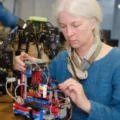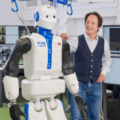Analog Neuromorphic Processors for ASICs/SoCs Offer Microwatt Edge AI
Electronic Engineering Journal, 20 November 2025
We live in exciting times with respect to AI and the devices used to implement inferencing at the edge, where the “internet rubber” meets the “real-world road,” as it were. It reminds me of those distant days in the 1970s when we were all “feeling our way” with 8-bit microprocessors. I’m thinking of devices like the Intel 8008 (1972), Intel 8080 (1974), Motorola 6800 (1974), MOS Technology 6502 (1975),…
New Artificial Neurons Physically Replicate the Brain
SciTechDaily, 2 November 2025
A breakthrough in neuromorphic computing could lower the energy consumption of chips and accelerate progress toward artificial general intelligence (AGI). Researchers from the USC Viterbi School of Engineering and the School of Advanced Computing have created artificial neurons that closely mimic the complex electrochemical behavior of real brain cells. Their breakthrough,…
China builds brain-mimicking AI server the size of a mini-fridge, claims 90% power reduction — BI Explorer 1 packs in 1,152 CPU cores and 4.8TB of memory, runs on a household power outlet
tom's HARDWARE, 28 October 2025
Chinese scientists have unveiled what they call the "world's first brain-inspired computing entity," an AI "supercomputer" called the BIE-1, inspired by the operation of the human brain. While this claim to be the world's first isn't entirely accurate, the BIE-1 still offers exciting neuromorphic performance numbers, reportedly featuring 1,152 CPU cores and 4.8 TB of DDR5 memory while claiming to consume…
Nuclear Startups May Miss the AI Power Boom as Efficiency Gains Explode
investing.com, 10 October 2025
This Technology May Slash AI Energy Use by 1,000x – Arriving Years Before Oklo’s First Reactor. Investors have poured $45 billion into zero-revenue nuclear startups like Oklo (NYSE:OKLO), betting AI data centers will drive insatiable power demand for decades. But a convergence of energy-efficient computing technologies already demonstrating 100-1,000x efficiency gains in laboratories threatens to…
A Theoretical Framework for Neuromorphic Technology?
EE Times Current, 10 October 2025
Brad Aimone from Sandia National Labs works with the world’s biggest neuromorphic platforms. In this episode of Brains and Machines, he talks to Sunny Bains of University College London about how this allows him to think deeply about what they’re good for. Discussion follows with Giulia D’Angelo from the Czech Technical University in Prague and Professor Ralph Etienne-…
Korea, with global semiconductor research, will make a huge investment in 10 years
MAEIL BUSINESS NEWSPAPER, 3 October 2025
The competitiveness of Korean researchers in neuromorphic semiconductors is among the top in the world. Korea is the market where we can see the result." Seok Min-koo, a professor of electrical engineering at Columbia University, told the Maeil Business Newspaper that Korea can gain an advantage in the paradigm shift of semiconductor technology as it shows strength in neuromorphic…
A New Brain-on-a-Chip May Usher in the Beginning of the Singularity
POPULAR MECHANICS, 23 September 2025
Here’s what you’ll learn when you read this story: Memristors, or “memory resistors,” are the leading candidate for replacing synapses in a neuromorphic (brain-like) computer. Earlier this year, Korea Advanced Institute of Science and Technology, or KAIST, announced the development of a self-learning memristor that’s even better at replicating the synapses in our brain. This could allow AI computing to occur locally while also being more energy efficient and capable of improving at tasks over time….
King’s joins UK’s first brain-inspired computing innovation centre
King's College London, 16 September 2025
Along with King’s academics from NMES and IoPPN, Professor Bipin Rajendran from the Department of Engineering will lead the King’s team which is part of the UCL-led Neuroware centre. The centre seeks to accelerate the development of next-generation brain-inspired computing technologies and their deployment onto computer chips. This will help underpin new advancements in edge AI,…
Neurons Close the Loop from Insect Perception to Action
EE Times Current, 10 September 2025
Professor Barbara Webb from the University of Edinburgh in Scotland uses physical robots to validate neural mechanisms in crickets, ants, and bees. In this episode of Brains and Machines, she talks to Dr. Sunny Bains of University College London about her work. Discussion follows with Dr. Giulia D’Angelo from the Czech Technical University in Prague and Professor Ralph Etienne-Cummings…
Neuromorphic computing: Mimicking the human brain for smarter AI
DATAQUEST, 29 August 2025
From Intel's Loihi to breakthroughs in memristors, neuromorphic computing offers potential breakthroughs with more energy-efficient, adaptive, and brain-like data processing capabilities that could change the way we build smarter and more sustainable AI. The first time I witnessed a child stack blocks, I felt like I was watching a miniature computer learn. She didn't plan the tower, she felt for balance…
International Success: Austrian Research Partnership Sets New Standards in Neuromorphic Computing
SAL Silicon Austria Labs, 26 August 2025
Unlike classical computers, which process information in bits, the human brain uses short electrical impulses—known as spikes. What matters is the precise timing of these spikes, which carries the actual information. This timing-based representation allows the brain to transmit more complex information per signal compared to a digital bit, which can only be “0” or “1.” The intervals between…
Researchers Unlock Faster Brain-Inspired Computing
QUANTUM ZEITGEIST, 21 August 2025
The pursuit of energy-efficient computing inspired by the human brain increasingly focuses on harnessing the movement of magnetic domain walls, tiny boundaries within magnetic materials, as a means of processing information. Jeffrey Brock, Aleksandr Kurenkov, and Aleš Hrabec, at the Laboratory for Mesoscopic Systems at ETH Zurich, alongside Laura Heyderman and colleagues, now demonstrate a significant…
“We’re building chips that think like the brain” — I got a front row seat to see how neuromorphic computing will transform your next smart device
tom's guide, 11 August 2025
For how powerful today’s “smart” devices are, they’re not that good at working smarter rather than working harder. With AI constantly connected to the cloud and the chip constantly processing tasks (even when the device is asleep), this leads to high power consumption, limited privacy, and the constant need for connectivity. Neuromorphic computing offers a radical alternative, but what is it?…
Can Neuromorphic Be Low-Power, Reconfigurable, and Scalable?
EE Times Current, 8 August 2025
Professor Gert Cauwenberghs has been working toward building brain-scale systems for decades. At the University of California San Diego, he’s now one of the leaders of the Neuromorphic Commons hub, also known as Thor, which will give the wider community access to neuromorphic hardware and simulators. In this episode of Brains and Machines, he talks to Dr. Sunny Bains of University College London about his approach…
The Rise of Neuromorphic Computing: How Brain-Inspired AI is Shaping the Future in 2025
A.I News Hub, 7 August 2025
Neuromorphic computing, an innovative AI paradigm mimicking the human brain’s neural architecture, is poised to redefine technology in 2025. With the global AI market projected to reach $4.8 trillion by 2033, neuromorphic systems offer energy-efficient, low-latency solutions critical for edge AI, robotics, and IoT. In China, the New Generation Artificial Intelligence Plan and startups like SynSense are driving…
SpiNNcloud Sells Neuromorphic Supercomputer For Drug Discovery
EE Times, 28 July 2025
Neuromorphic hardware startup SpiNNcloud has sold a supercomputer based on its chips to the University of Leipzig, where it will be used for drug discovery. The 4320-chip system is based on the second generation of SpNNaker brain-inspired hardware, commercialized by SpiNNcloud. The new multi-million-Euro system at the University of Leipzig will simulate protein folding for research into personalized medicine….
What is meant by Neuromorphic Computing – A webinar debate
IOP Publishing, 24 July 2025
There are two main approaches to what we consider neuromorphic computing. The first involves emulating biological neural processing systems through the physics of computation of computational substrates that have similar properties and constraints as real neural systems, with potential for denser structures and advantages in energy cost. The other simulates neural processing systems on scalable…
How can neuromorphic devices be harnessed in edge AI computing?
EE World Online, 23 July 2025
Neuromorphic computing, which mimics the human brain’s architecture and function, can be leveraged in edge computing to improve power efficiency, speed, and adaptability. By processing data locally and using event-driven computation, neuromorphic chips can optimize resource usage in edge AI applications, reducing reliance on centralized cloud processing….
Memristors go mainstream: brain-inspired hardware could cut AI’s energy costs
Ingenia, 12 July 2025
Professor Themis Prodromakis designs neuromorphic AI hardware that takes cues from the brain. Aside from slashing AI’s energy use, it could also make for smarter spacecraft and brain-computer interfaces. AI’s energy costs are skyrocketing. In April 2025, the International Energy Agency (IEA), which monitors the world’s energy use, forecasted that electricity demand from datacentres will double to…
Event-Driven E-Skins Protect Both Robots and Humans
EE Times Current, 10 July 2025
Professor Gordon Cheng builds humanoid robots that can feel their environment using artificial skin. In this episode of Brains and Machines, he talks to Dr. Sunny Bains of University College London about how the skin was designed, how it improves safety, and why neuromorphic engineering will be important for machine autonomy. Discussion follows with Dr. Giulia D’Angelo from the Czech Technical University…




















